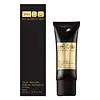What's inside
What's inside
 Key Ingredients
Key Ingredients

 Benefits
Benefits

 Concerns
Concerns

 Ingredients Side-by-side
Ingredients Side-by-side

Water
Skin ConditioningGlycerin
HumectantC13-15 Alkane
SolventDicaprylyl Carbonate
EmollientEthylene/Acrylic Acid Copolymer
Emulsion StabilisingC12-16 Alcohols
EmollientSodium Polyacrylate
AbsorbentPalmitic Acid
EmollientSodium Potassium Aluminum Silicate
Phenoxyethanol
PreservativeSodium Stearoyl Glutamate
CleansingHydrogenated Lecithin
EmulsifyingHydroxyethyl Acrylate/Sodium Acryloyldimethyl Taurate Copolymer
Emulsion StabilisingEthylhexylglycerin
Skin ConditioningCaprylyl Glycol
EmollientSilica
AbrasiveDisodium EDTA
Sodium Hydroxide
BufferingParfum
MaskingPolysorbate 60
EmulsifyingSorbitan Isostearate
EmulsifyingSodium Hyaluronate
HumectantPoloxamer 338
EmulsifyingPEG-8
HumectantTocopherol
AntioxidantCirsium Eriophorum Callus Extract
AstringentMica
Cosmetic ColorantAscorbyl Palmitate
AntioxidantAscorbic Acid
AntioxidantCitric Acid
BufferingTocopheryl Acetate
AntioxidantCI 77891
Cosmetic ColorantCI 77491
Cosmetic ColorantWater, Glycerin, C13-15 Alkane, Dicaprylyl Carbonate, Ethylene/Acrylic Acid Copolymer, C12-16 Alcohols, Sodium Polyacrylate, Palmitic Acid, Sodium Potassium Aluminum Silicate, Phenoxyethanol, Sodium Stearoyl Glutamate, Hydrogenated Lecithin, Hydroxyethyl Acrylate/Sodium Acryloyldimethyl Taurate Copolymer, Ethylhexylglycerin, Caprylyl Glycol, Silica, Disodium EDTA, Sodium Hydroxide, Parfum, Polysorbate 60, Sorbitan Isostearate, Sodium Hyaluronate, Poloxamer 338, PEG-8, Tocopherol, Cirsium Eriophorum Callus Extract, Mica, Ascorbyl Palmitate, Ascorbic Acid, Citric Acid, Tocopheryl Acetate, CI 77891, CI 77491
Dimethicone
EmollientWater
Skin ConditioningDimethicone/Vinyl Dimethicone Crosspolymer
Skin ConditioningVinyl Dimethicone/Methicone Silsesquioxane Crosspolymer
Trimethylsiloxysilicate
EmollientSilica
AbrasiveGlycerin
HumectantCetyl PEG/PPG-10/1 Dimethicone
EmulsifyingIsododecane
EmollientPhenoxyethanol
PreservativeSodium Chloride
MaskingDimethicone/PEG-10/15 Crosspolymer
Magnesium Sulfate
Sodium Benzoate
MaskingDisteardimonium Hectorite
StabilisingC24-28 Alkyl Methicone
EmollientPropylene Carbonate
SolventDipropylene Glycol
HumectantSodium Citrate
BufferingTocopherol
AntioxidantDimethicone, Water, Dimethicone/Vinyl Dimethicone Crosspolymer, Vinyl Dimethicone/Methicone Silsesquioxane Crosspolymer, Trimethylsiloxysilicate, Silica, Glycerin, Cetyl PEG/PPG-10/1 Dimethicone, Isododecane, Phenoxyethanol, Sodium Chloride, Dimethicone/PEG-10/15 Crosspolymer, Magnesium Sulfate, Sodium Benzoate, Disteardimonium Hectorite, C24-28 Alkyl Methicone, Propylene Carbonate, Dipropylene Glycol, Sodium Citrate, Tocopherol
 Reviews
Reviews

Ingredients Explained
These ingredients are found in both products.
Ingredients higher up in an ingredient list are typically present in a larger amount.
Glycerin is already naturally found in your skin. It helps moisturize and protect your skin.
A study from 2016 found glycerin to be more effective as a humectant than AHAs and hyaluronic acid.
As a humectant, it helps the skin stay hydrated by pulling moisture to your skin. The low molecular weight of glycerin allows it to pull moisture into the deeper layers of your skin.
Hydrated skin improves your skin barrier; Your skin barrier helps protect against irritants and bacteria.
Glycerin has also been found to have antimicrobial and antiviral properties. Due to these properties, glycerin is often used in wound and burn treatments.
In cosmetics, glycerin is usually derived from plants such as soybean or palm. However, it can also be sourced from animals, such as tallow or animal fat.
This ingredient is organic, colorless, odorless, and non-toxic.
Glycerin is the name for this ingredient in American English. British English uses Glycerol/Glycerine.
Learn more about GlycerinPhenoxyethanol is a preservative that has germicide, antimicrobial, and aromatic properties. Studies show that phenoxyethanol can prevent microbial growth. By itself, it has a scent that is similar to that of a rose.
It's often used in formulations along with Caprylyl Glycol to preserve the shelf life of products.
Silica, also known as silicon dioxide, is a naturally occurring mineral. It is used as a fine, spherical, and porous powder in cosmetics.
Though it has exfoliant properties, the function of silica varies depending on the product.
The unique structure of silica enhances the spreadability and adds smoothness, making it a great texture enhancer.
It is also used as an active carrier, emulsifier, and mattifier due to its ability to absorb excess oil.
In some products, tiny microneedles called spicules are made from silica or hydrolyzed sponge. When you rub them in, they lightly polish away dead skin layers and enhance the penetration of active ingredients.
Learn more about SilicaTocopherol (also known as Vitamin E) is a common antioxidant used to help protect the skin from free-radicals and strengthen the skin barrier. It's also fat soluble - this means our skin is great at absorbing it.
Vitamin E also helps keep your natural skin lipids healthy. Your lipid skin barrier naturally consists of lipids, ceramides, and fatty acids. Vitamin E offers extra protection for your skin’s lipid barrier, keeping your skin healthy and nourished.
Another benefit is a bit of UV protection. Vitamin E helps reduce the damage caused by UVB rays. (It should not replace your sunscreen). Combining it with Vitamin C can decrease sunburned cells and hyperpigmentation after UV exposure.
You might have noticed Vitamin E + C often paired together. This is because it is great at stabilizing Vitamin C. Using the two together helps increase the effectiveness of both ingredients.
There are often claims that Vitamin E can reduce/prevent scarring, but these claims haven't been confirmed by scientific research.
Learn more about TocopherolWater. It's the most common cosmetic ingredient of all. You'll usually see it at the top of ingredient lists, meaning that it makes up the largest part of the product.
So why is it so popular? Water most often acts as a solvent - this means that it helps dissolve other ingredients into the formulation.
You'll also recognize water as that liquid we all need to stay alive. If you see this, drink a glass of water. Stay hydrated!
Learn more about Water